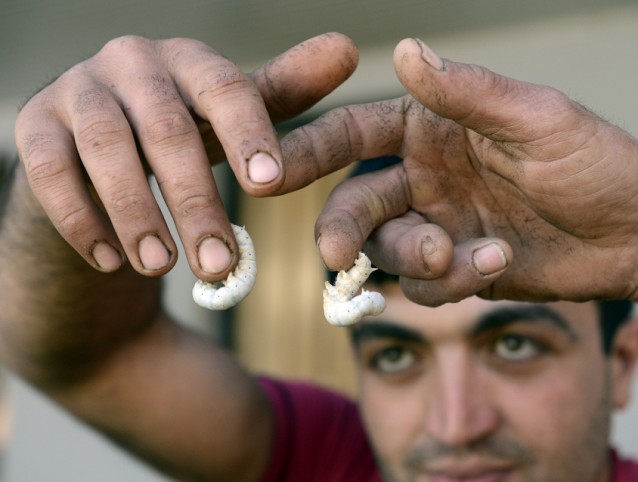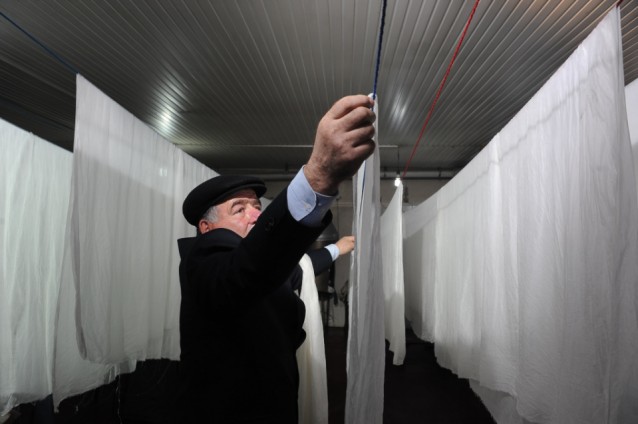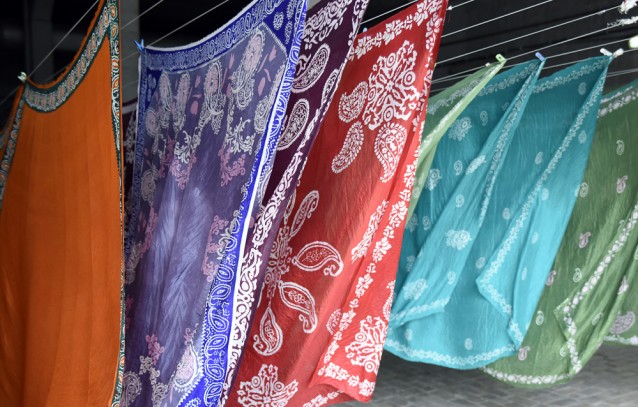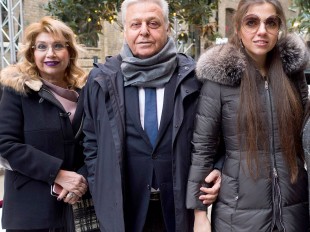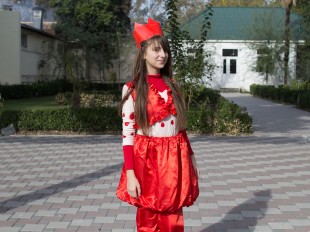Imbued with mesmerizing colour and design, kelaghayi headscarves have been worn by Azerbaijani women for centuries and, alongside mugham and carpets, are one of the most treasured symbols of the country’s rich culture. Their production harks back to the days of the Silk Road, which passed along the foothills of the Caucasus Mountains in northern Azerbaijan, introducing an array of tools, produce and raw materials to the region. Sericulture became widespread in Sheki and Shamakhi and the village of Basqal in the Ismayilli region became a hub of kelaghayi craftsmanship.
Aiming to uncover this ancient art from all possible angles, an exhibition entitled Kelaghayi: Past-Present-Future opened at the Kichik QalArt gallery in Icherisheher on 21 December 2018. It distinguishes itself from previous kelaghayi-themed events in terms of its scope: with contributors ranging from the Tbilisi Museum of Silk to contemporary designers, collectors and historians, the exhibition unites the leading figures involved in research, recording, manufacture and modernisation of this unique craft, which was included in UNESCO’s Representative List of the Intangible Cultural Heritage of Humanity in 2014.
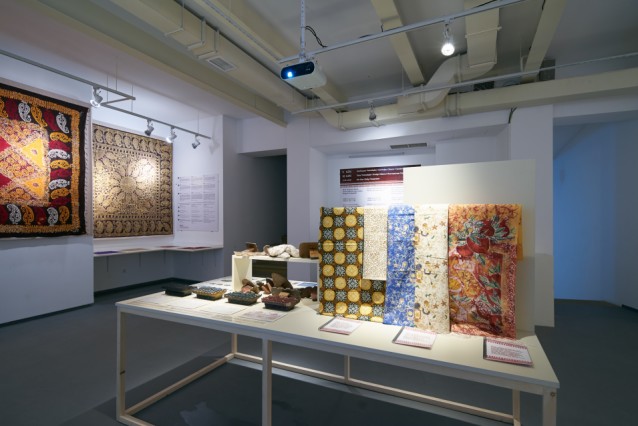 The first floor of the exhibition explores the history of kelaghayi making. Photo: courtesy of Asli Samadova
The first floor of the exhibition explores the history of kelaghayi making. Photo: courtesy of Asli Samadova
Eager to dig deeper into the history and culture of the kelaghayi, I called in recently and caught up with its curator, Asli Samadova, who gave me a private tour. According to Asli, a self-taught curator and a pioneer of independently produced exhibitions in Azerbaijan, Kelaghayi: Past-Present-Future has been conceived over several years, although her interest in the kelaghayi goes back much further:
Since I was a teenager I could say that I was one of the early adopters of kelaghayi culture, wearing a kelaghayi while it was not yet stylish or in fashion. When I was 13 I went to Sheki and bought a kelaghayi and it has been one of my favourite scarves since then. My interest in textiles and carpets brought me to Basqal in 2015 where I learnt more about the kelaghayi. It was there that I thought of an exhibition.
Asli continues: This exhibition has been organised as part of the Milli Irsimiz (Our National Heritage – Ed.) curatorial project aimed at studying and popularizing the national culture from a broad perspective. It has been conceived as a travelling exhibition and thus is made with respect to all international textile conservation and museum standards.
As the title suggests, the exhibition is separated into three chapters – past, present and future, with exhibits spanning over three floors. The top floor, where the exhibition begins, gives plenty of historical background and homes in on how sericulture developed in Azerbaijan. Visitors discover how dyeing and printing techniques evolved along the Silk Road and an interactive display compares the kelaghayi with Indonesian batik cloth and Georgian supras (tablecloths), two similar crafts found along this great route. The techniques are almost identical: in all three cases patterns are applied to naturally dyed fabric using a wooden stamp (qelib in Azerbaijani), the main difference being that supras and batiks use cotton rather than silk. A kelaghayi, on the other hand, must be made from silk, just as it must be large – and nearly square-shaped – and embellished with exquisite ornaments.
It’s on this level too that one learns about the mechanics of kelaghayi making. The process involves three stages: weaving, dyeing and decorating a silk fabric using a technique known as hot batik, which means stamping the material with patterns of hot wax that stop the dye from penetrating. There’s also a video produced by the Ministry of Culture and Tourism featuring an interview with Professor Rena Ibrahimbekova, who along with her husband Jalil Tariverdiyev, is responsible for reviving kelaghayi making in its historical home of Basqal.
Revival and tradition
Indeed, the revival of this ancient craft is a key focus of the exhibition. Despite the uniformity of fashion during the Soviet Union, Azerbaijani kelaghayis continued to be widely produced albeit with a simplified design, lower quality of fabric and occasional ideological symbols, whether it were Lenin’s portrait or a little Moskvich (as per the example exhibited). But with the closure of silk factories after the fall of the USSR, the ensuing political upheaval and Karabakh conflict, the kelaghayi craft was on the verge of disappearance until Professor Ibrahimbekova founded the Basqal Kelaghayi Centre in 2003. All of this is recounted at the beginning of the exhibition.
Descending a level, the story continues by comparing and contrasting the ways in which kelaghayis are worn across Azerbaijan and their regional variations in design and especially colour, which depends on natural dyes rendered from the local vegetation. A central interactive display invites visitors to create their own kelaghayi designs and leave comments on how they view the national scarf’s future. But it’s the video exhibit to the left of the entrance that grabs my attention. According to Asli, collectors Fuad Jabrayilov and Rustam Huseynov spent years travelling across Azerbaijan, collecting old kelaghayis and listening to family stories of how they were worn passed down orally from generation to generation. The video, by multimedia artist Chinara Majidova, models the various modes of wearing while several kelaghayis and a mirror have been provided for visitors to experiment themselves. Information is also given here on how the kelaghayi differs from other Azerbaijan scarves – orpeks, shawls and charshafs.
Traditionally, the kelaghayi’s purpose was practical and not for posing or even propaganda. It protected women from exposure to wind and sun, and the silk kept their heads warm in winter and cool in summer. Like carpets, they vary in pattern and colour from region to region and some believe they are similarly rich in philosophical meaning. I recall once being told at the Carpet Museum that A carpet is like a love letter to the sun, before spending the next few hours with two of the country’s leading experts trying to interpret each rug’s signs and symbols only to eventually be told that, To be honest, even we don’t know what it all means. While kelaghayis are no doubt made with a similar warmth and affection and do feature similar ornaments (the buta is especially common), nowadays Asli cautions against reading into them too scientifically.
That being said, a kelaghayi’s appearance is still far from meaningless. In a video shown on the first floor, Ali Talibov, a kelaghayi craftsman in Basqal, explains that red kelaghayis are traditionally worn by brides, green by women of faith and brown by the elderly. What’s more, kelaghayis have historically played a role in key life events. For example, Azerbaijani girls would traditionally accept a marriage proposal by gifting their suitor with their kelaghayi, and, improbable as it may sound, a kelaghayi thrown by a woman among feuding men had the power to prevent bloodshed. While today the latter role may have fizzled out, it’s still the case that a bride’s face should be hidden by a red kelaghayi on her wedding day until rings are exchanged during the marriage ceremony.
Fashion and identity
While some traditions remain, the kelaghayi’s modernization is another key thread running through the exhibition. Undoubtedly, kelaghayis have become a favourite souvenir for the country’s growing number of tourists, but even among patriotic Azerbaijani women they have seen a big resurgence: Women here will have at least one kelaghayi in their wardrobe, maybe more, but they try to blend it in with their contemporary daily fashion or wear it on special occasions or national holidays, Asli said.
The bottom floor of the exhibition is especially interesting in this regard as it presents the work of modern designers. While brands such as Azerbaijan Kelaghayi, El Carré and silk manufacturer Sheki Ipek are sticking to more classical designs, Dastan (the brand produced by the Icherisheher centre of traditional arts) takes its inspiration from the history of Baku’s Old City and local designer Menzer Hajiyeva is attracting global attention with her contemporary Western adaptations. Incidentally, kelaghayis today cost anything from 60 to 150 manats, the price depending on the complexity of the dyeing and printing process.
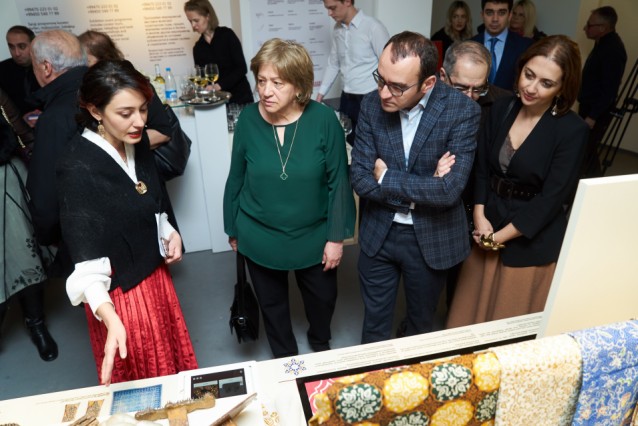 Curator Asli Samadova speaks to guests during the exhibition's opening on 21 December 2018. Photo: courtesy of Asli Samadova
Curator Asli Samadova speaks to guests during the exhibition's opening on 21 December 2018. Photo: courtesy of Asli Samadova
Also on this floor visitors can explore the kelaghayi’s representation in art and film. On the former, among exquisite works by the likes of Tahir Salahov, Sattar Bahlulzade and Azim Azimzade, of special interest is an intriguing painting by Czech artist Alphonse Mucha which Asli stumbled across in Prague in 2015 while hurrying to a concert.
The painting is called The Star, or alternatively Winter Night, and belongs to Mucha’s series of epic paintings on Slavic culture. It features a starving Russian woman lying in the snow praying for salvation while three wolves wait for what seems her inevitable death, although a star shining brightly in the background suggests a glimmer of hope. This was Mucha’s response to the terrible famine he witnessed in the Volga region during his trip to Russia in 1913, but uncharacteristically for these frozen wintery landscapes, the desperate woman wears a kelaghayi, which begs the question – why? After consulting Azerbaijani experts and even one of Mucha’s descendants, the most plausible version Asli heard is that Mucha probably acquired the kelaghayi in a market selling Sheki silk products near Moscow’s Red Square and attributed it to Russian culture. Whatever the reality, it’s a thought-provoking story and aptly demonstrates the scope of research that went into producing the exhibition.
And that’s the overriding sense one leaves with upon exiting. Kelaghayi: Past-Present-Future examines the story of one of the nation’s favourite symbols from all possible angles, while also highlighting its ability to endure and evolve, as both a fashion item and a marker of national identity. After all, for some women wearing a kelaghayi is simply a way of saying – I am Azerbaijani.
|
Kelaghayi: Past-Present-Future
21 December 2018 – 15 May 2019 Kichik QalArt Gallery
Kichik Qala, 58
Icherisheher, Baku
Opening hours: Tuesday – Sunday 11am – 8pm
Follow the exhibition on Facebook and Instagram at
@kelaghayi_exhibition_baku
|
